Topics
- Board Games (4)
- Card Games (1)
- Events (3)
- Musings (5)
- News (1)
- Party Games (1)
- Uncategorized (4)
- Video Games (20)
A diary of sorts, wherein I moonlight as a games writer. Under haphazard construction.
Not being one for console shooters, I didn’t come into Destiny 2 with the same expectations carried by fans of the original, and as such found myself rather enjoying the difficult followup act to the cult hit that many others dismissed. I had a really good time for the 40-odd hours I spent with it, but when it came to shelling out for more via the DLC pass I just wasn’t feeling it. I spent a month or so doing laps of the endgame content available to me, and dipped my toe again at Christmas for the seasonal festivities, but soon drifted away. Whilst the shooting was fun still, the skinner box of constant incremental progress had ceased to tickle. Now the new Forsaken expanion’s bundling in the first two pieces of DLC for free, I’ve been feeling myself drawn back again.
Some of this is nostalgia for the cozy evenings spent playing it last year as the season turned cold, but there’s something else there too. Something unique to Destiny that it’s taken me a few days to put my finger on, and that has come to me now whilst sitting here and waiting for the 80gb download to finish. The grandeur.
When I think of Destiny 2, one of the first things that springs to mind is the main menu music. Yes, partially because I spent a not-insignificant amount of time listening to it whilst the game servers were struggling, but also because it captures so well the atmosphere the game strives to achieve. Destiny takes itself seriously. It’s a lore-heavy space fantasy epic that focuses a massive corona of glowing pseudo-religious magic bollocks into a laser point, through then lens of good old earthly gun-fetishism. How does it carry this off whilst still maintaining it’s straight face (and slyly concealing the cold statistical machinery below)? Majesty. Splendour. Grandeur.
Everything is sleek, and gilt, and magnificent. Orchestral scores soar. The names of weapons and armour pieces hark back to myths and legends that, whilst mostly superficial, succeed in lending you the feel of being part of a lineage of epic celestial heroes. Your foes are ancient and primordial- simply the natural darkness to your light. The backstory is gubbins, but like the skyboxes of the planets you roam, presents a glorious illusion of depth- a starry tapestry encompassing you so thickly that you can’t see where the edges lie. Even at the low levels where the story sees you brought low and conducting your operations from a humble abandoned farmstead you are made to feel like your rightful place is amongst the heavens, and when (surprising nobody) you reclaim it at the end of the story, it feels good to be home. I say this as someone who never set foot in the first game’s Citadel beyond the free PS3 alpha.
I am excited about stepping back into the filigree boots of my Guardian again because it feels like I will once more be answering a call. Rejoining the ranks of the space wizard heroes and be set adrift once again on their sea of endless cosmic lore. It’s an impressive feat for a glorified loot treadmill to have achieved, and a masterclass of set-dressing.
Anyway, download’s finished. Back to the radio silence.
Prophecies and chosen ones are ten a penny in videogames, but I can’t think of any outside of Arcanum which involve ogres in aeroplanes shooting down a zeppelin.
Reborn on wings of fire indeed.
Beau Loosefingers, a Halfling orphan with a questionable set of skills, wakes up amid the wreckage of a job gone South to receive the dying pleas of an old gnome. Find the boy and give him this ring. Also some dark sounding stuff about stopping something from ending the world and killing everyone. That sounded like it was his fault. Whatever. Ring please. Which way’s town?
Then Virgil shows up.
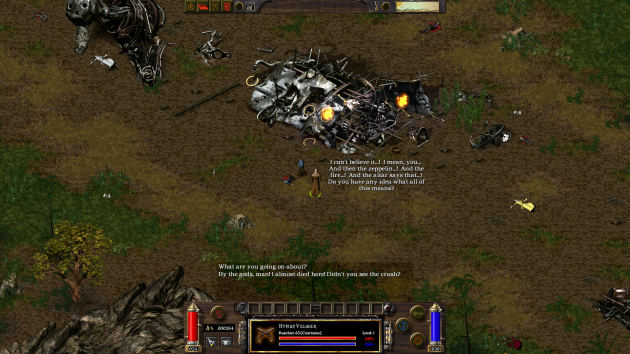
By the gods indeed
Virgil, Virgil, Virgil. New to the Panarii religion and face to face with his messiah before he’s even learned their name. Or the name of the dark lord they’re supposed to fight. Or the words of the prophecy foretelling their reincarnation. Or practically any of his holy scriptures at all. Helplessly and hilariously in over his head, all he can do is desperately try to persuade his living god to come with him back to a temple where there are some real priests. But god is not listening. God is busy emptying the pockets of the crash victims. And running away from boars. And gathering scrap metal. Hold these springs, we’ll get a few quid for them later.
Beau has quickly realised that Virgil will not allow his freshly reincarnated saviour to be eaten by wolves, which is handy, because Beau is small, weak and can’t fight for shit. With no points in Melee and a Strength of 5, his chance of hitting most enemies is no more than 25%. Against bouncy little sewer rats, it’s 5%. So a regular hit against them is about as likely as an awesome critical hit on D&D. Critical misses are a big thing in Arcanum too, so his dagger seems to spend as much time stuck in the ground from a fumbled attack as stuck in his enemies. When I went to the character sheet to spend his first sweet sweet stat point (on a rank in Dodging, aka hiding behind Virgil), I noticed he’d picked up a scar somehow which was reducing his Beauty stat. It turned out to be *self inflicted*. I was initially thinking of giving him some ranks in ranged combat so he could use firearms, but now I’m not so sure.
Speaking of failing to hit Sewer Rats, this happened.
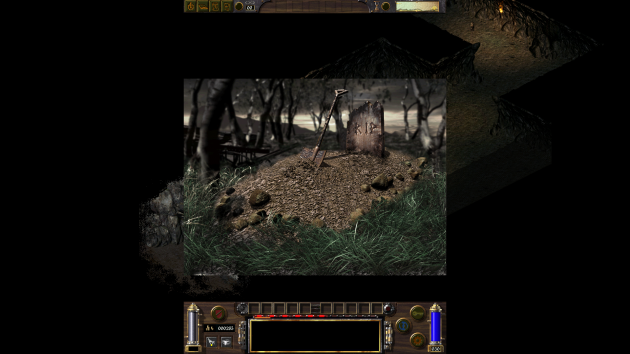
..an embarrassing number of times.
So we’ll be coming back to clear out the rat cave later, then.
In a clearing off to the other side of the crash stands a magic-looking red chest protected by a small blue shaman and a wolf. Virgil made short work of the wolf, but Beau required so much healing that he then fell *physically unconscious* from the effort of keeping him alive. Arcanum has no mana points, all spell casting is done via stamina, and this even applies to NPCs. Which is why, in attempting to kill the unconscious Virgil, the shaman also collapsed from exhaustion. Coup de grace, fight over, right? Wrong. Beau can’t even stab a small blue creature that’s lying face down on the ground. He has to wait for Virgil to wake up who.. promptly passes out once more. It takes two more attempts for him to recover sufficiently to finish the fight.
The chest contains some very fancy white robes, which Beau recognises from the sprite to probably not be cursed ones and so quickly dons. There’s some armour too, but that looks like it could be hexed, so Virgil’s gonna have to wait before wearing it.
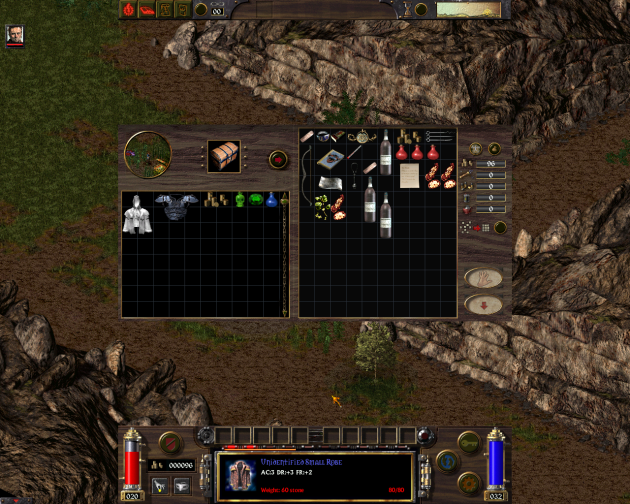
Not a bad haul!
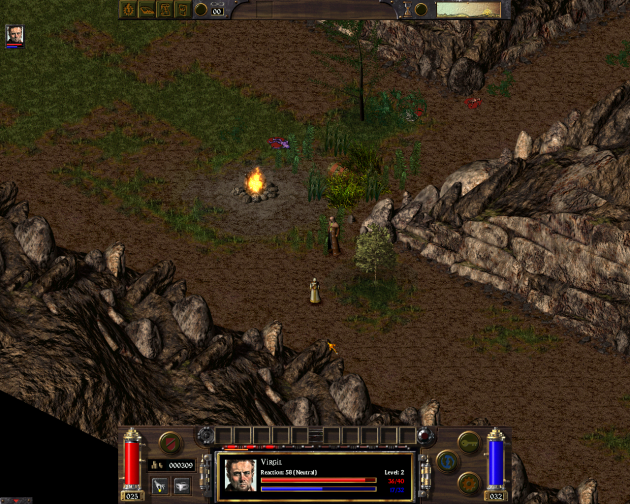
Beau and Virgil stand triumphant
Looking suitably messianic and satisfied that, with the exception of one rat-infested cave, he’s picked the crash site clean, it’s off to Shrouded Hills to try and clear up all this Panarii nonsense.
Arcanum: Of Steamworks and Magicka Obscura came out 15 years ago today.
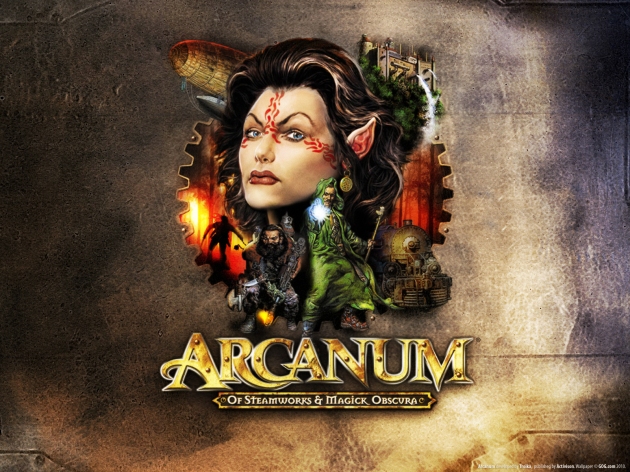
This masterpiece.
This blows my mind because it was (I think?) one of the very first games which I played on a demo disk that really, really got under my skin. I played a lot of demos as a kid, most of which I enjoyed, and then almost entirely forgot about. Game reviews gave me my recommendations of things to play, coverdisk demos were short, disposable free games.
Most demos used to give you a very narrow slice of gameplay to experience in order to tease you with the promise of more. RTS’ would give you a short early mission with just basic units and have a splash screen at the end showing the big crazy impressive ones. Old shareware SHMUPs would let you play one or two stages and only earn enough cash to buy the basic ship upgrades in the store leaving the more impressive ones tantalisingly beyond your reach. FPS’ would give you a mission or two at the start of the game filled with basic grunts and maybe one or two weapons besides the starting pistol and creative re-skinning of a melee attack. Usually they were just enough to have fun with for an hour or two before uninstalling and putting something else on. In rare and special cases however, they provided as much entertainment as full games themselves.
I’m wandering. This isn’t a nostalgia bend on how much I miss magazine cover disks. I’ve still not finished the one about mods and mutators and that’s been overdue for more than a year. I’ll get back to Arcanum in a second.
RPGs would often give you a pre-built character or party to run through a small chunk of the story with. Maybe you’d get to level up a bit and pick an ability or two from limited available options, or find some cool random gear or sidequests hidden away from the beaten path, but for the most part you were given some toys to play with, one or two interesting long-term plot hooks to wonder about, and invited to buy the full game if you wanted to know whether the protagonist ever recovered from their amnesia.
Where Arcanum differed was that it threw the toybox open *wide*. Instead of dropping you into a pre-defined scenario, the devs Troika simply let you start a whole new game, fresh from the beginning, with the entirety of the character creator and the first two areas open to you. You could be whoever you wanted to be, and then the Zeppelin crash site and Shrouded Hills were your oyster. The options available were the sort of thing you’d usually see boasted about on a splash screen as being available if you bought the full game once you’d finished playing. Sixteen Magickal colleges, eight Technological Disciplines, and sixteen [obligatory] skills split between four different [generic] categories. Eight playable races and 26 character backgrounds, which not only affect the six basic ability scores but also bring into play other unique factors such as dialogue limitations.
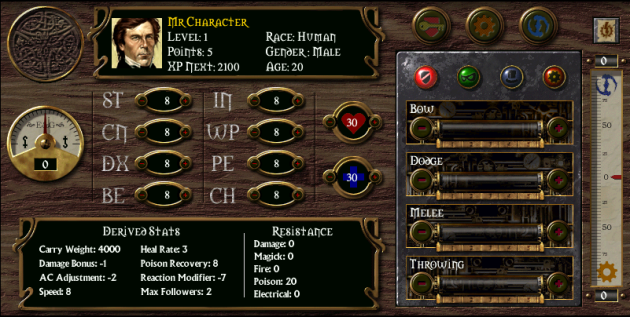
Look at all those buttons! You get to click them five times to begin with.
Nothing was closed off to you, and thanks to the point-based progression system there were no fixed character classes to limit your decisions. So long as you could achieve the prerequisite ability scores required for casting spells and gain enough experience to level up and learn them, you could try the first two or three spells of all the different Colleges of Magick. There was enough junk littered around at the crash site to allow you to craft at least the first if not also the second item of each of the Tech Disciplines. You could max your Strength stat and level your weapon skills up enough to murder everyone in town. You could invest the points required to Sneak and Pick Locks well enough to rob the shopkeeper of all his rarest and most interesting magickal wares and sell anything you didn’t need back to him. You could be Charismatic enough to convince the resident drunk, Sogg Mead-Mug to join your party. Resolve the Toone mystery, stop the bank robbery, mock Lucan the Witless, and do it *however you like*. Then do it again with a completely different selection of skills. Then see whether you can make the Hand Cannon (boo, you can’t). Then see whether you can level up enough to cast third-level spells (yay, you can!). Then cast Summon Undead in the middle of town and what the hell is a Bone Butcher AND WHY IS IT HOSTILE OH DEAR GOD *RUN*!
Thus was many an afternoon spent.
This spirit of experimentation carried through so thoroughly into the full game that it was a struggle to ever commit to one character for long. As in most RPGs, you simply can’t do everything, and the choices you made always left other paths left tantalisingly untravelled. Something you didn’t see in the short term offered by the demo was how investment in Magick destroys your character’s aptitude for technology, and how embracing modern science and invention severs your link to the Universe’s Magickal energies. If you want to play with one, you have to forgo the other. Similarly, mastering all five spells of each of the sixteen Colleges requires so many skillpoints that I’m not entirely sure is even possible, and the same can also be said for the forty technological inventions tied to the eight Disciplines. You have to choose what kind of spellcaster or inventor you want to be (if you want to be either at all), and stick with those decisions over the course of a game that could last you over a hundred hours. Whilst there are an impressive number of recruitable followers who allow you to play with the toys you decided to leave in the box, only the one character is your own to fully customise.
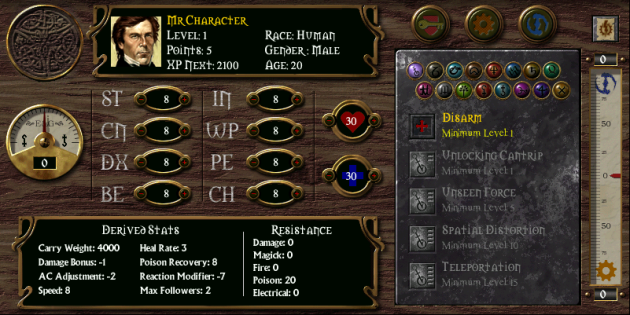
Whilst each College of Magick only had 5 spells, there were more than you could shake a shillelagh at.
Every time I’ve re-installed Arcanum in these 15 years since it was first released, I have started an entirely fresh game with an entirely new character. If I still had all of my save games, each one would tell a vastly different story of which corner of the game I had decided to explore at the time. Destructive Magicks, Firearms and Explosives, Buffs and Debuffs, pure Melee, pure Social skills, impenetrable defense, mixed Magick and Tech (ew.), low Intelligence. Criss-crossing the character sheet from page to page, visiting archetypes and creating my own, each lasting somewhere in the tens to dozens of hours before my attention wandered away to other builds or other games entirely.
For Arcanum’s 15th anniversary I’m putting it back on again, but for my latest game I’m going to do something different. Or rather, something that isn’t different.
Instead of aiming to cast the best spell of yet another Magick College I’ve only read about in the game manual, or to create some inventions I’ve still never had all the parts for (sword-launching gun, medical arachnid and flamethrow ffs.), I’ve decided to return to a character archetype that has been my go-to default in more different games than I can count for just about as long as I can remember.
I’ve rebuilt Beau Loosefingers, the Halfling Thief.
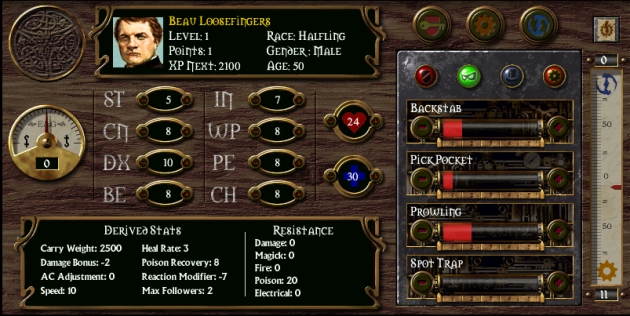
Looking something like this. Maybe. I’ve not actually started yet.
And I’m going to write a few diary entries about him.
I don’t know whether it will go on for as long as my Wasteland 2 diaries did, and I expect it’ll probably end in a similarly unsatisfying fashion, but I’ve been looking for a new excuse to write here lately, and this is the first thing that’s really inspired me. I’ll aim to do writeups in a similar style to the Wasteland ones, summarising the highlights of one or two play sessions at a time, with looks at the characters’ development and plot progress along the way. They won’t be very frequent, but I’ll work on them whenever I’m not climbing, boardgaming or playing No Man’s Sky. I have a day off tomorrow and a few afternoons of holiday next week before finishing my current job, so at least one should get finished.
I’d still like to get back to nostalgically exploring my love of game mods in the early 00s at some point, but for now, this is an Arcanum diary.
Okay, so here’s something a bit different. The other night I stumbled across something buried amongst the oldest files on my external storage drive which made me feel like a kid again. Something I have been carefully copying from computer to computer for over a decade. It was an archive of dozens and dozens of old Nerf Arena maps and Unreal Tournament mods, downloaded by myself, sometime circa 1999-2002.
Tonight I want to revel in a little nostalgia, and give you a look into a lost world that I used to inhabit during some of my earliest days on the internet. Back when The Simpsons was still funny, my Neopets were still alive, and my most-visited webpage looked like this:
Tonight I’m gonna ramble on a bit about various game mods, and how they were probably some of the most fun and interesting things I played during my early gaming days.
Originally I was just gonna write about the first Unreal Tournament, but thinking on it a little more yesterday I realised that I was just as deeply invested in the mod scene of Half-Life, and those of both games’ sequels, Unreal Tournament 2004 and Half-Life 2. I’ve tinkered with Jedi Knight II, Quake 3, Dawn of War, and plenty of other games too, most recently Skyrim, but I think the four games of those two series neatly bookend my experiences within what I’d call the golden age in the mid 00s. I have memories and experiences I’d like to recall and explore for all of them, and think I will probably do it in a post or two for each. Maybe one wandering around the scene itself, then another diving into my favourite parts of it.
UT99’s what I’ve been playing this weekend, what inspired me to get writing this, and what’s mostly filling my head right now, so that’s where I’ll start. Or at least, somewhere fairly near there. I’ll get to showing off some of the crazy mods themselves eventually, but it’ll be a meandering path on the way there. I wanna start off just recalling how I even ended up on the scene in the first place.
One of the main reasons I started this place was so that I’d have somewhere to ramble on about games I really like without inflicting too much of my insufferable enthusiasm on unfortunate friends and passers-by, which isn’t really how I’ve been using it thus far.
Here we go.
Tragedy Looper didn’t convince me at first, but it turns out that this was because we were playing it wrong. We misunderstood something quite important, which is easily done to be fair, because it’s fucking complicated. There is an absolute mountain to climb before you will fully get your head around all the paranoia, intrigue, goodwill, roles, incidents and characters (and which of the above are and aren’t related to one another), but when you do.. oh wow.
Tragedy Looper’s a Japanese board game which sorta defies classification. It’s about time travel, detective work, bluffing, and in its final stages ends up vaguely resembling a demented kind of Chess. Every game follows a scripted scenario over the course of a number of days with one player acting as a Mastermind trying to complete a nefarious deed or two, and the other three attempting to stop them any way they can. The players start out in a state of abject confusion with no information about what the Mastermind’s win condition is, or what role any of the characters on the board will play in the script. By watching events unfold, they must begin to deduce what’s going on and try to successfully intervene. Or, like, just lose their shit completely in a fit of blind panic.
That guy was alone with the girl when she died. The other dude died alone apparently at random. Nobody who goes to the hospital comes out alive. The Shrine Maiden appears to be chasing that Schoolboy. A suicide was presaged on this day. Oh. dear. god.
Maybe the protagonists will play their movement cards to try and keep the murderous guy and the girl apart, maybe they’ll attempt to keep the suicidal dude’s spirits up by reducing his paranoia, maybe they’ll try and stop anyone going to the hospital by forbidding them by moving at all. And maybe it’ll be all for nothing when a bomb goes off and everyone dies anyway.
When the Mastermind completes their objective, they announce that the loop is closed, and time resets itself to the beginning of the first day. The Protagonists can then share their thoughts before everything starts again, trying to work out what the fuck just happened to them. I forgot to mention that throughout all this the Protagonists are not allowed to communicate with one another, which to begin with is every bit as insane as it sounds.
If the Mastermind wins the requisite number of times, the Protagonists get a chance to guess the identities of all the characters, and if they fail that, it’s game over. If the Protagonists even once manage get to the end of the number of days listed in the script without the Mastermind winning, then that’s it, they win everything.
The stakes are high on both sides, with every completed loop bringing the Protagonists closer to failure, but simultaneously providing them with more vital information about the roles of the characters and the Mastermind’s intentions. The Mastermind is utterly reliant on surprise, feeling the tricks up their sleeves dwindle as they listen in despair to the players’ discussions bringing them closer and closer to the mark.
All this writing has been a bit dry so far, because conveying the atmosphere during this game whilst giving a clear explanation of how it all works is actually really difficult. So much of the game hangs on lack of explanations, the lack of clarity in the chaotic events which occur. As the Mastermind it is utterly hilarious to simultaneously kill three characters, using three different means, and watch the players reaction of complete and utter WHAT THE FUCK as they desperately try to decipher which one was the key to the loop rebooting, and how they can go about averting it the following time.
The scripts I’ve played so far (and there are ten in the box to begin with, with guides for making your own) have all been broad enough to offer the opportunity for plenty of red herrings, and because the Protagonists don’t know what or even how many win conditions the Mastermind has, separating the truth from the decoys is a nightmare. All they have to help them is a forewarning of which days the special Incidents will occur upon, and the knowledge that roles of characters in the script will conform to one or more of the Plots written on their reference cards. No sign of a Serial Killer? Maybe the “Shadow of the Ripper” plot is not one of the ones that’s active. Pretty sure that guy’s a Conspiracy Theorist? Maybe we’re playing with “Unsettling Rumours”. He just placed some intrigue counters on the hospital.. does that mean it’s about to explode?
The design is just masterful. To begin with all the players are trying to do is gather information- work out which roles are active, which each of the characters on the board are playing, and what the Mastermind’s objectives are. But as the loops tick by, the nature of the game subtly changes. By the last loop they probably know who the killers are, they know whose lives they need to preserve; but can they actually do it? Can they prevent the Mastermind from moving all his pieces into place? Keep the Police Officer away from the Office Worker on the day of the murder? Stop anyone being left alone with the Doctor? Prevent the Boy Student’s paranoia reaching its limit on the day of the suicide? Chess. Sorta.
It’s such a nightmare to initially learn, though. Hopefully you’ve got a reasonable idea of how it works from my writing, but in practice you need to get your head around exactly what Paranoia tokens will do, why they’re different to Intrigue, and how someone could theoretically be the culprit of the “Murder” Incident, but not the “Killer” role. Three separate characters might die, one killed by the Killer, one killed by the Serial Killer, and one killed by the culprit of the Murder, and they’d all be under completely different circumstances with different clues as to which was which. I’m not entirely convinced the cheat sheets with every single role, character, incident, plot and subplot listed on them really help with the inevitable information overload here, but they’re sorta essential to the players’ detective work.
Learning shouldn’t take more than a single full game, and over the course of that game you’ll learn the characters and roles in play inside out, but that’s still a couple of hours of your life that you need to invest before you even start to get the best of it. It should go without saying I think it’s totally worth it, though. If only because I am in sore need of more people to play with so I can stop Masterminding and try the player side out for once. It’s fun pulling the strings, but the pressure knowing that a single slip-up will cost you everything is a bit intense, even if you do start out holding all the cards.
So yeah, give it a look! Or like, at the very least, don’t get that deer-in-the-headlights look when I start yelling at you to let me teach you. I just wanna play moar..